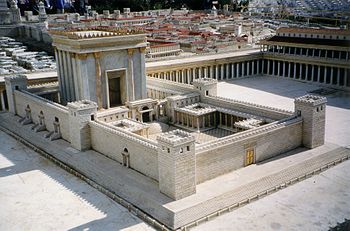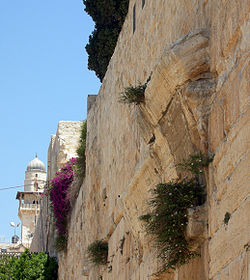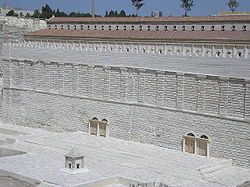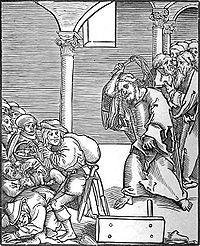- Second Temple
-
The Jewish Second Temple was an important shrine which stood on the Temple Mount in Jerusalem between 516 BCE and 70 CE. It replaced the First Temple which was destroyed in 586 BCE, when the Jewish nation was exiled to Babylon. Both temples were centres of Jewish sacrificial worship and are still most important today in the politics and history of Judaism.
The accession of Cyrus the Great of Persia in 538 BCE made the re-establishment of the city of Jerusalem and the rebuilding of the Temple possible.[1] According to the Bible, when the Jewish exiles returned to Jerusalem following a decree from Cyrus the Great (Ezra 1:1-4, 2 Chron 36:22-23), construction started at the original site of Solomon's Temple, which had remained a devastated heap during the approximately 70 years of captivity (Dan. 9:1-2). After a relatively brief halt due to opposition from peoples who had filled the vacuum during the Jewish captivity (Ezra 4), work resumed c. 521 BCE under the Persian King Darius (Ezra 5) and was completed during the sixth year of his reign (c. 518/517 BCE), with the temple dedication taking place the following year.
Around 19 BCE, Herod the Great renovated the Temple, which became known as Herod's Temple.
The Romans destroyed Jerusalem and its Temple in 70 CE under Titus, decidedly ending the Great Jewish Revolt that had begun four years earlier. The lower levels of the Western Wall form part of the few surviving remains of Herod's complex.[2]
Traditional rabbinic sources state that the Second Temple stood for 420 years and based on the 2nd-century work Seder Olam Rabbah, place construction in 350 BCE (3408 AM), 166 years later than secular estimates, and destruction in 70 CE (3829 AM).[3]
Contents
Rebuilding the Temple
 A stone (2.43x1 m) with Hebrew inscription "To the Trumpeting Place" excavated by Benjamin Mazar at the southern foot of the Temple Mount is believed to be a part of the Second Temple
A stone (2.43x1 m) with Hebrew inscription "To the Trumpeting Place" excavated by Benjamin Mazar at the southern foot of the Temple Mount is believed to be a part of the Second Temple
Based on the biblical account, after the return from Babylonian captivity under Zerubbabel, arrangements were almost immediately made to reorganize the desolated Yehud Province after the demise of the Kingdom of Judah seventy years earlier. The body of pilgrims, forming a band of 42,360,[4] having completed the long and dreary journey of some four months, from the banks of the Euphrates to Jerusalem, were animated in all their proceedings by a strong religious impulse, and therefore one of their first concerns was to restore their ancient house of worship by rebuilding their destroyed Temple and reinstituting the sacrificial rituals known as the korbanot.
On the invitation of Zerubbabel, the governor, who showed them a remarkable example of liberality by contributing personally 1,000 golden darics, besides other gifts, the people poured their gifts into the sacred treasury with great enthusiasm.[5] First they erected and dedicated the altar of God on the exact spot where it had formerly stood, and they then cleared away the charred heaps of debris which occupied the site of the old temple; and in the second month of the second year (535 BCE), amid great public excitement and rejoicing, the foundations of the Second Temple were laid. A wide interest was felt in this great movement, although it was regarded with mixed feelings by the spectators.[6][7]
The Samaritans made proposals for co-operation in the work. Zerubbabel and the elders, however, declined all such cooperation, feeling that the Jews must build the Temple without help. Immediately evil reports were spread regarding the Jews. According to Ezra 4:5, the Samaritans sought to "frustrate their purpose" and sent messengers to Ecbatana and Susa, with the result that the work was suspended.
Seven years later, Cyrus the Great, who allowed the Jews to return to their homeland and rebuild the Temple, died,[8] and was succeeded by his son Cambyses. On his death, the "false Smerdis," an imposter, occupied the throne for some seven or eight months, and then Darius I of Persia became king (522 BCE). In the second year of this monarch the work of rebuilding the temple was resumed and carried forward to its completion,[9] under the stimulus of the earnest counsels and admonitions of the prophets Haggai and Zechariah. It was ready for consecration in the spring of 516 BCE, more than twenty years after the return from captivity. The Temple was completed on the third day of the month Adar, in the sixth year of the reign of King Darius, amid great rejoicings on the part of all the people[10] although it was evident that the Jews were no longer an independent people, but were subject to a foreign power. The Book of Haggai includes a prediction that the glory of the second temple would be greater than that of the first.[11]
Missing articles
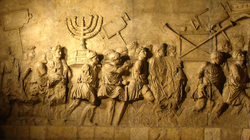 Roman triumphal procession with spoils from the Temple, depicted on the inside wall of the Arch of Titus in Rome
Roman triumphal procession with spoils from the Temple, depicted on the inside wall of the Arch of Titus in Rome
Since some of the original artifacts were, according to the biblical account, lost after the destruction of the First Temple, the Second Temple lacked the following holy articles:[12]
- The Ark of the Covenant, containing the Tablets of Stone, the pot of manna, and Aaron's rod
- The Urim and Thummim (parchment contained in the Hoshen)
- The holy oil
- The sacred fire.
In the Second Temple, the Kodesh Hakodashim (Holy of Holies) was separated by curtains rather than a wall as in the First Temple. Still, as in the Tabernacle, the Second Temple included:
- The Menorah (golden lamp) for the Hekhal
- The Table of Showbread
- The golden altar of incense, with golden censers.
The Second Temple also included many of the original vessels of gold that had been taken by the Babylonians but restored by Cyrus the Great.[13] According to Jewish tradition, however, the Temple lacked the Shekinah/Ruach HaKodesh present in the first.
Rededication by the Maccabees
Following the conquest of Judea by Alexander the Great, it became part of the Ptolemaic Kingdom of Egypt until 200 BCE, when King Antiochus III the Great of Syria defeated King Ptolemy V Epiphanes of Egypt at the Battle of Panion.[14] Judea became at that moment part of the Seleucid empire of Syria. When the Second Temple in Jerusalem was looted and its religious services stopped, Judaism was effectively outlawed. In 167 BCE, Antiochus ordered an altar to Zeus erected in the Temple. He also banned circumcision and ordered pigs to be sacrificed at the altar of the Temple.[15]
Following the Maccabean Revolt against the Seleucid empire, the Second Temple was rededicated and became the religious pillar of the Jewish Hasmonean kingdom, as well as culturally associated with the Jewish holiday of Hanukkah.
Herod's Temple
Herod's Temple in Jerusalem was a massive expansion of the Temple Mount platform and major expansion of the Jewish Temple by King Herod the Great around 19 BCE.
Herod's Temple to God is believed to have been a renovation and reconstruction of the Second Temple building, while religious worship and temple rituals continued during the construction process.[16]
Following the Great Revolt of the Province of Iudaea, the Temple was destroyed by Roman troops under Titus during the Siege of Jerusalem in 70 CE. The most complete ancient account of this event is The Jewish War by Flavius Josephus. Later Roman and Byzantine governors used the remains to build palaces, a Temple of Jupiter, and a Church. It was not until the Dome of the Rock was built between 687 and 691 that the last remnants of the Temple were taken down. In addition to the platform, some remnants of the Temples remain above ground, including a step leading to the Dome of the Rock that is actually the capstone of the pre-Herodian wall of the Temple Mount platform.[17]
The Temple itself was located on the site of what today is the Dome of the Rock. The gates let out close to Al-Aqsa.[16]
Construction
Herod's Temple was one of the larger construction projects of the 1st century BCE. Herod was interested in perpetuating his name for all eternity through building projects, and his construction program was extensive. He had magnificent palaces in Masada, Caesarea and Tiberias. Herod built temples for various pagan gods to serve the gentile populations, which were paid for by heavy taxes on the local Jewish population.[18]
But his masterpiece was to be the Temple of Jerusalem. The old temple, built by Zerubbabel nearly half a millennium before, despite frequent renovation, most notably by the Maccabees in the century before, was still run down and relatively small.
In 20 BCE, Herod announced that the old temple would be torn down and replaced with something truly magnificent. The Kohanim, or Jewish priesthood, as well as the rest of the population, were skeptical, requiring Herod to quarry all the stones required for the project before the destruction of the Post-Exile structure could begin.
An agreement was made between Herod and the Jewish religious authorities: the sacrificial rituals, called korbanot, were to be continued unabated for the entire time of construction, and the Temple itself would be constructed by the Kohanim.
Mt. Moriah had a plateau at the northern end, and steeply declined on the southern slope. It was Herod's plan that the entire mountain be turned into a giant square platform. The Temple Mount was originally intended to be 1600 feet wide by 900 feet deep by 9 stories high, with walls up to 16 feet deep, but had never been finished. To complete it, a trench was dug around the mountain, and huge stone "bricks" were laid. Some of these weighed well over 100 tons, the largest measuring 44.6 feet by 11 feet by 16.5 feet and weighing approximately 567 to 628 tons,[19][20] while most were in the range of 2.5 by 3.5 by 15 feet (approximately 28 tons). King Herod had architects from Greece, Rome and Egypt plan the construction. The blocks were presumably quarried by using pick axes to create channels. Then they hammered in wooden beams and flushed them with water to force them out. Once they were removed, they were carved into precise squares and numbered at the quarry to show where they would be installed. The final carving would have been done by using harder stones to grind or chisel them to create precise joints. They would have been transported using oxen and specialized carts. Since the quarry was uphill from the temple they had gravity on their side but care needed to be taken to control the descent. Final installation would have been done using pulleys or cranes. Roman pulleys and cranes weren't strong enough to lift the blocks alone so they may have used multiple cranes and levers to position them.[21] Several experiments moving megaliths with ancient technology were done at other locations some of them are listed here. As the mountainside began to rise, the western side was carved away to a vertical wall and bricks were carved to create a virtual continuation of the brick face, which was continued for a while until the northern slope reached ground level. Part of the Antonian hill to the north of Moriah was annexed to the complex and the area between was filled up with landfill.
The project began with the building of giant underground vaults upon which the temple would be built so it could be larger than the small flat area on top of Mount Moriah. Ground level at the time was at least 20 ft. (6m) below the current level, as can be seen by walking the Western Wall tunnels. The edge of this platform remains everywhere; part of it forms the Western Wall.
In 1967 Israel captured Old Jerusalem (and the Temple Mount) from Jordan. It was found that the wall extended all the way around the Temple Mount and is part of the city wall near the Lion's Gate. Thus, the Western Wall is not the only remaining part of the Temple Mount. Currently, Robinson's Arch (named after American Edward Robinson) remains as the beginning of an arch that spanned the gap between the top of the platform and the higher ground farther away. This had been used by the priests as an entrance. Commoners had entered through the still-extant, but now plugged, gates on the southern side which led through beautiful colonnades to the top of the platform. One of these colonnades is still extant and reachable through the Temple Mount. The Southern wall was designed as a grand entrance. Recent archeological digs have found thousands of mikvehs (ceremonial bathtubs) for the ritual purification of the worshipers, as well as a grand stairway leading to the now blocked entrance.
Inside the walls, the platform was supported by a series of vaulted archways, now called Solomon's Stables, which still exist and whose current renovation by the Waqf is extremely controversial.
As for the temple itself, it was made, not of local stone, as was the rest of the complex, but imported white marble, which was in sharp contrast to the entire city and gleamed in the daylight.
Legend has it that the construction of the entire complex lasted only three years, but other sources such as Josephus say that it took far longer, although the Temple itself may have taken that long. During a Passover visit by Jesus the Jews replied that it had been under construction for 46 years.[22] It is possible that the complex was only a few years completed when the future Emperor Titus burnt the place to the ground in 70 CE.
Life in and around the temple
In the decades after the suppression of the Bar Kochba revolt, the 2nd century CE Jewish sage Judah ha-Nasi, fearing that a Third Temple would not be built in his lifetime, committed to writing the Mishnah in order to keep the "oral law," including the rules pertaining to the functioning of the temple ceremonials and precincts, intact for that day when the sacrifices might begin again.[23]
The Gemara, a commentary on the Mishnah, provides many details of the architecture of Herod's temple, as well as what life was like in and around the temple. This has aided modern researchers in painting a clear picture of what the Temple Mount was like during the time of Jesus.
Reaching Jerusalem
Christ drives the Usurers out of the Temple, a woodcut by Lucas Cranach the Elder in Passionary of Christ and Antichrist.[24]
A Jew from distant parts of the Roman Empire would arrive by boat at the port of Jaffa (now part of Tel Aviv), where he or she would join a caravan for the three day trek to the Holy City (a trip which only takes about an hour by automobile today), and would then find lodgings in one of the many hotels or hostelries. Once lodging was secured and money changed, the pilgrim would purchase a sacrificial animal, usually a pigeon or a lamb, in preparation for the following day's events.
Access to the temple
The gleaming white marble of the edifice was visible from well outside the walls of the city. The scale of the building was designed to impress, and it dominated the landscape, effectively becoming the focal point of Jerusalem. Even the three great towers near Herod's palace seemed small in comparison.
The first thing a pilgrim would do would be to approach the public entrance on the south side of the Temple Mount complex. He would check his animal, then visit a mikveh, where he would ritually cleanse and purify himself. The pilgrim would then retrieve his sacrificial animal, and head to the Huldah gates. After ascending a staircase three stories in height, and passing through the gate, the pilgrim would find himself in the "Court of the Gentiles."
The Court of the Gentiles
This area was primarily a bazaar, with vendors selling souvenirs, sacrificial animals, food, as well as currency changers, exchanging Roman for Tyrian money because the Jews were not allowed to coin their own money and they viewed Roman currency as an abomination to the Lord,[25] as also mentioned in the New Testament account of Jesus and the Money Changers. Guides that provided tours of the premises were also available. Jewish males had the unique opportunity to be shown inside the temple itself.
The Kohanim (Priests), in their white linen robes and tubular hats, and directed pilgrims where and advising them what kind of sacrifices were to be performed.
Behind one as they entered the Court of the Gentiles was the Royal Portico, which contained a marketplace, administrative quarters, and a synagogue as well. On the upper floors, the great Jewish sages held court, Cohanim and Levites performed various chores, and from there tourists were able to observe the events.
To the east of the court was the Portico of Solomon, and to the north, the Soreg, a giant stone structure separating the public area from the area where only Jews could enter. Within the soreg was the temple itself.
Inside the Soreg
According to Josephus, there were ten entrances into the inner courts, four on the south, four on the north, one on the east and one leading east to west from the Court of Women to the court of the Israelites, named the Nicanor Gate.[26] The gates were: On the south side (going from west to east) the Fuel Gate, the Firstling Gate, the Water Gate. On the north side, from west to east, are the Jeconiah Gate, the Offering Gate, the Women's Gate and the Song Gate. On the Eastern side, the Nicanor gate, which is where most Jewish visitors entered via the Nicanor gate.
A few pieces of the Soreg have survived to the present day; see the photograph at right.
The Court of the Women
Within this area was the court of the women where all Jews, male and female, were permitted. Even a ritually unclean Cohen could enter to perform various housekeeping duties. There was also a place for lepers (considered ritually unclean), as well as a ritual barbershop for Nazirites. In this, the largest of the temple courts, there could be seen constant dancing, singing and music.
The Court of the Israelites
This area was exclusively for Jewish men to enter. The Jewish men could see the animal sacrifices made by the high priest in the court of the priests.
The Court of the Priests
The Court of the Priests was reserved for Levite priests who performed sacrifices, including lambs, doves, and pigeons.
The Temple itself
Between the entrance of the building and the curtain veiling the Holy of Holies were the famous vessels of the temple: the menorah, the incense-burning altar, and various other implements.
Discovery of quarry
On September 25, 2007 Yuval Baruch, archaeologist with the Israeli Antiquities Authority announced the discovery of a quarry compound which may have provided King Herod with the stones to build his Temple on the Temple Mount. Coins, pottery and an iron stake found proved the date of the quarrying to be about 19 BCE. Archaeologist Ehud Netzer confirmed that the large outlines of the stone cuts is evidence that it was a massive public project worked by hundreds of slaves.[27]
Second Temple Judaism
Main article: Second Temple JudaismThe period between the construction of the Second Temple in 515 BCE and its destruction by the Romans in 70 CE witnessed major historical upheavals and significant religious changes that would affect most subsequent Western (or Abrahamic) religions. The origins of the authority of scripture, of the centrality of law and morality in religion, of the synagogue and of apocalyptic expectations for the future all developed in the Judaism of this period.
Destruction
In 66 CE the Jewish population rebelled against the Roman empire. Four years later, in 70 CE, Roman legions under Titus retook and subsequently destroyed much of Jerusalem and the Second Temple. The Arch of Titus, located in Rome and built to commemorate Titus's victory in Judea, depict a Roman victory procession with soldiers carrying spoils from the Temple, including the Menorah. Although Jews continued to inhabit the destroyed city, Jerusalem was razed by the Emperor Hadrian at the end of the Bar Kokhba revolt in 135 CE when he established a new city called Aelia Capitolina.
The destruction date according to the Hebrew calendar was the 9th of Av,[citation needed] also known as Tisha B'Av (29 or 30 July 70).[citation needed]
See also
- Bar Kochba Revolt
- First Temple
- Jerusalem stone
- Jerusalem’s Model in the Late 2nd Temple Period
- Herodian architecture
- List of artifacts significant to the Bible
- List of megalithic sites
- Replicas of the Jewish Temple
- Siege of Jerusalem (70)
- Temple of Peace, Rome
- Third Temple
- Timeline of Jewish history
- Tisha B'Av
References
- ^ Samuelson, Norbert Max. Revelation and the God of Israel, Cambridge University Press, 2002. pg. 226. ISBN 052181202X
- ^ Porter, J.R. The Illustrated Guide to the Bible, Oxford University Press US, 1998. pg. 91. ISBN 0195214625
- ^ Goldwurm, Hersh. History of the Jewish people: the Second Temple era, Mesorah Publications, 1982. Appendix: Year of the Destruction, pg. 213. ISBN 089906454X
- ^ Ezra 2:65 HE
- ^ Ezra 2
- ^ Haggai 2:3
- ^ Zechariah 4:10
- ^ 2 Chronicles 36:22-23
- ^ Ezra 5:6-6:15
- ^ Ezra 6:15,16
- ^ Haggai 2:9
- ^ Jewish Encyclopedia, temple The Second Temple
- ^ Ezra 1:7-11
- ^ De Bellis Antiquitatis (DBA) The Battle of Panion (200 BC)
- ^ Flavius Josephus, The Wars of the Jews Jewish War i. 34
- ^ a b Secrets of Jerusalem's Temple Mount, Leen Ritmeyer, Kathleen Ritmeyer, 1998
- ^ The End of Days: Fundamentalism and the Struggle for the Temple Mount, Gershom Gorenberg, Oxford University Press US, 2002, 78
- ^ Flavius Josephus: The Jewish War
- ^ The History Channel cited the 16.5 depth 567 ton estimate in "Lost Worlds of King Herod"
- ^ Dan Bahat: Touching the Stones of our Heritage, Israeli ministry of Religious Affairs, 2002
- ^ "Modern Marvels: Bible tech" History channel
- ^ Gospel of John 2:20
- ^ Ariel, Israel and Richman, Chaim:Carta's Illustrated Encyclopedia of the Holy temple in Jerusalem Carta Publishing, Jerusalem, Israel. 2005
- ^ The references cited in the Passionary for this woodcut: 1 John 2:14-16, Matthew 10:8, and The Apology of the Augsburg Confession, Article 8, Of the Church
- ^ Beasley-Murray, G. (1999). Word biblical commentary: John (2 ed., Vol. 36). Nashville, Tennessee: Thomas Nelson.
- ^ Josephus, War 5.5.2; 198; m. Mid. 1.4
- ^ USATODAY.com, Report: Herod's Temple quarry found
External links
- Resources > Second Temple and Talmudic Era > Second Temple Jerusalem The Jewish History Resource Center, Project of the Dinur Center for Research in Jewish History, The Hebrew University of Jerusalem
- Jewish Encyclopedia: Temple, The Second
- 4 Enoch: The Online Encyclopedia of Second Temple Judaism
- Jerusalem Videos The Southern & Western walls in Jerusalem - The Temple Mount
- Resources > Second Temple and Talmudic Era > Second Temple Jerusalem The Jewish History Resource Center, Project of the Dinur Center for Research in Jewish History, The Hebrew University of Jerusalem
- Temple Mount Photos The Temple Mount photos including sites below the Mount itself, off limits to any non-Muslims
- Resources > Second Temple and Talmudic Era > Herod and the Herodian Dynasty The Jewish History Resource Center - Project of the Dinur Center for Research in Jewish History, The Hebrew University of Jerusalem
- Jewish Encyclopedia: Temple of Herod
- PBS Frontline: Temple Culture
- Picture gallery of a model of the temple
- Resources > Second Temple and Talmudic Era > Second Temple Jerusalem The Jewish History Resource Center, Project of the Dinur Center for Research in Jewish History, The Hebrew University of Jerusalem
- Jewish Encyclopedia: Temple, The Second
- 4 Enoch: The Online Encyclopedia of Second Temple Judaism
Temple in Jerusalem Structures Tabernacle · First Temple / Solomon's Temple · Second Temple / Ezra's Temple / Herod's Temple · Third Temple / Ezekiel's TempleElements Altar · Ark of the Covenant · Shekhinah · Holy of Holies · Seven-branched candelabrum · Foundation Stone · Mercy seat · Solomon's Porch · Temple treasury · Boaz and Jachin · Western Wall · Warren's Gate · Western Stone · Wilson's Arch · The Sanctuary · Molten Sea · Urn for ashes of the Red HeiferPriesthood Priestly sash · Ephod · Holy anointing oil · Breastplate · Priestly tunic · High Priest · Sacrifice · Priestly robe · Linen undergarments · Turban · Priestly divisions · Shemen Afarsimon · Priestly crown · Urim and Thummim · Priestly covenantHistory Temple Mount See also Hanukkah Traditions Symbols- Menorah (Hanukiah)
- Dreidel (Sevivon)
- Gelt
- Public menorah
Foods- "Ma'oz Tzur (Rock of Ages)"
- "Dreidel Song"
- "Oh Chanukah"
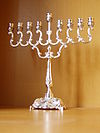
Maccabean Revolt Events- Seleucid Empire
- Temple in Jerusalem
- Maccabees
- Hasmonean Kingdom
Historical accountsPeople- Mattathias
- Simeon
- Eleazar
- Jonathan
- Judah
- Antiochus IV Epiphanes
- List of Judean rulers
BattlesThis article incorporates text from Easton's Bible Dictionary (1897), a publication now in the public domain.
Categories:- Second Temple
- Numeric epithets
Wikimedia Foundation. 2010.




